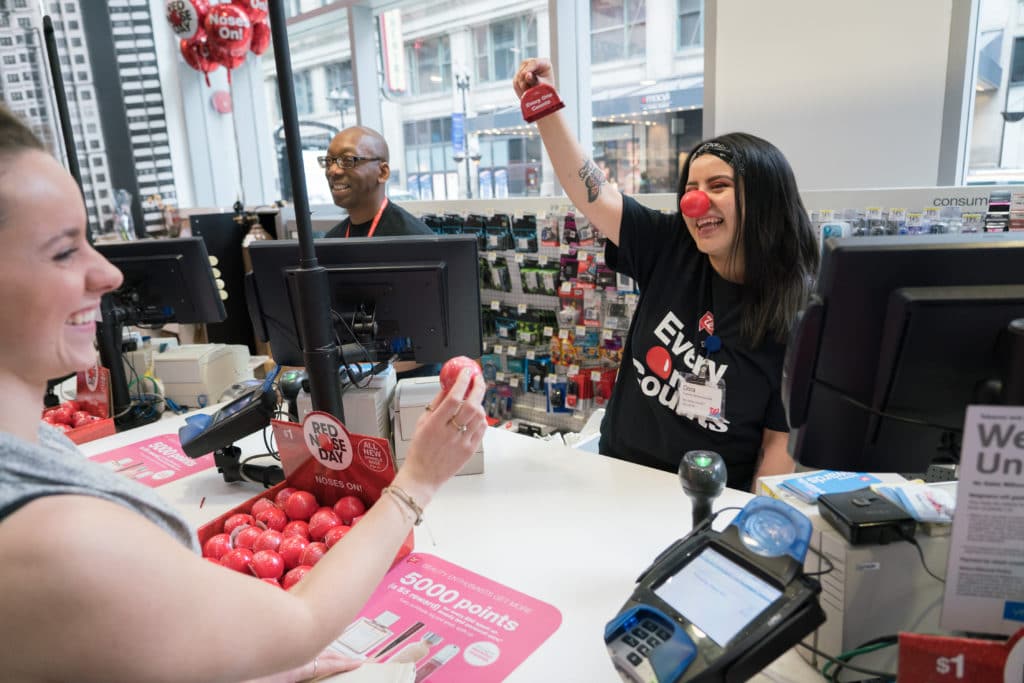In healthcare terms, a red nose is usually a bad sign, but Walgreens has turned it into a fundraising tool with its annual sponsorship of Red Nose Day USA, a fundraiser of the Comic Relief organization targeting child poverty. Walgreen’s has sponsored the campaign for the last four years and this year’s effort raised over $42 million for the charity.
Partnering with other cause-related efforts is part of the company’s purpose to make healthcare accessible to more consumers, said Walgreens CMO Adam Holyk.
Besides Red Nose Day, the company also partners with the UN Foundation on its Get a Shot, Give a Shot program that has now helped provide over 20 million vaccinations to children around the world, with Vitamin Angels to provide 140 million vitamin doses to children, as well as with the ME to WE organization to generate 50 million gallons of clean water.
The drugstore chain went through a rebranding last year, dropping its longtime “At the Corner of Happy and Healthy” tagline for “Trusted since 1901” in order to leverage its heritage and position itself as more customer-centric at a time of change in healthcare.
Holyk spoke to Velocitize about the importance of causes in healthcare marketing, the place of digital tools in it, and the changing landscape for pharmacy retailers.
Why this involvement in causes as part of your marketing?
Our involvement has been part of the Walgreens DNA going all the way back to 1901 and our purpose to champion the health and well-being of communities across America. That complemented with this emerging expectation from our consumers and our patients; they’re really looking for corporations in order to be able to do good and help with more social causes.
Your rival CVS made news by dropping cigarette sales as part of a healthcare positioning. What’s your healthcare strategy?
For us it really is this idea of helping provide accessible healthcare in local communities, something we’ve always done as part of our roots and heritage within pharmacy.
That’s now evolving. We have several partnerships and pilots on the way on providing local healthcare services on optical and hearing, as well as our clinics and urgent care. More recently, we announced expanding a pilot with LabCorp to provide diagnostic services.
Those are some really tangible ways where consumers are looking for that low-cost, better quality access to healthcare in communities that we’re supporting. We’ve been able to bring that to life through our digital channels, whether that is our partnership working with MD Live around consultations through digital, or our pharmacy chat capability that allows our consumers to talk to one of our expert pharmacists 24 hours a day, 7 days a week.
How have digital tools affected your marketing?
We’re really proud of our digital capabilities and our mobile app. We’ve now had 50 million downloads of the Walgreens App and today has a five-star rating on both Apple and Android stores.
This is really around meeting the consumer and continuing to innovate, something Walgreens has always done to stay relevant with consumers. Today, we now have over 20% of our prescription refills though our mobile app and that translates into a prescription refill ever second through our mobile app. It’s absolutely key and people view it as an important tool in order to manage their medications and their healthcare.
Are you leveraging tools such as machine learning and natural language processing?
There are many different capabilities that sit behind the mobile app and we use the machine learning and thinking in how we do analytics and predictive analytics to deliver more relevant messages to consumers. That’s really underpinned with our loyalty platform—now over 88 million consumers are part of that—to deliver value and relevance to our consumers.
So is this focus on customer experience the new marketing?
It is. It really comes to life through our people and the experience and care they demonstrate in stores.
One great example I would highlight around the interaction of the experience and the capabilities was in response to what happened after the hurricanes. The work that our teams did immunizing first responders and being there with mobile pharmacies and setting up to look after patients at the (Houston) convention center was absolutely remarkable.
Our team members were able to look after them in person and also get them engaged on our digital app and allow them to manage and receive alerts when their prescriptions would be ready. From that experience we’ve seen utilization of our digital app through that market.
What we hear from consumers is this idea within purpose and cause around transparency and the local nature of giving. In Red Nose Day, what we saw this year around the tragedies that happened in Puerto Rico were the monies that were raised last year through Red Nose Day were redeployed into those communities this year to help in the wake of that tragedy. It was a real-life example of the good our consumers and team members can do, how it helps support those local communities.
How have the changes like the Affordable Care Act and the CVS-Aetna merger shaped how you approach marketing?
Obviously, the market is changing. We believe it gives us an even greater opportunity to help deliver accessible healthcare in communities, whether that is the expansion of some of the healthcare services, but also, I would add the idea of helping on drug affordability.
So what comes next in Walgreen’s marketing?
We’ll be stepping into our summer program and our summer campaign. That we’ll start making public in the following weeks in broadcast and in our stores. It’s another example of where Walgreens can deliver with this expertise to help people stay healthy in summertime period. It’s clearly consistent with our purpose.
